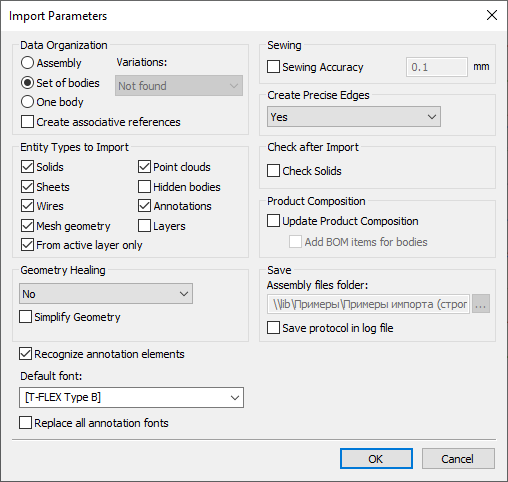Import from Neutral Formats and Formats of Other CADs |
  
|
Similar import parameters dialog is used for 3DXML, ACIS, Autodesk Inventor, Catia V4, Catia V5, CGR, Creo/ProE, I-Deas, IGES, JT, PRC, Rhino, Siemens NX (Unigraphics), Solid Edge, SolidWorks, STEP, U3D, VDA-FS formats.

Data Organization
Following modes are available:
•Assembly
The model will be imported with the creation of the assembly structure. New documents are created on the disk for storing of the fragments and the assembly. After the import is completed, the created assembly file will be opened in the T-FLEX CAD window.
•Set of Bodies.
The model will be imported as a set of independent external models corresponding to the individual parts of the assembly. The imported model is added to the current T-FLEX CAD document.
•One Body
The result of the import is single body. The result is similar to the result of using the External Model command.
Create associative references
If the checkbox is enabled, the system tries to recreate associative dependencies between imported objects, similar to the ones existing in the source file.
Variations
If the system detects variations of the part or assembly selected for import, you can import a particular variation or all variations, depending on the option selected in this drop-down list.
For variations to be available for import, additional files may be required. The set of required files depends on the format of import.
Importing variations from Creo requires variations in *.xpr or *.xas format and a family table in *.ptd format being placed into the same folder as the base part or assembly selected for import.
Entity Types to Import
In this group you can specify types of objects to be imported into the document:
•Solids
•Surfaces
•Constructions (sketches, axes, points)
If constructions import is enabled, you may additionally import objects of following types:
oCurves/Profiles
oCoordinate systems
oPlanes
•Mesh geometry
•Point clouds
Points are imported as 3D Nodes.
•Annotations (3D)
•Layers
Below you can also filter objects by their visibility:
•Hidden bodies
With this checkbox disabled, hidden objects of any types are not imported. With this checkbox enabled, hidden objects are imported, if their type checkboxes are enabled.
•On active layer
If this checkbox is enabled objects, belonging to layers non-corresponding to active filters won't be imported.
Materials are imported, when importing the geometry they are applied to.
When importing from some formats, you may also import variables and attributes. To do so, you should specify the data to be imported in a special file before import (see Import of Variables and Attributes Using Configuration File).
Geometry Healing
You can select one of the following healing options:
•Yes
The system tries to correct the erroneous geometry in the imported model and receive a correct body. Potential errors may take place due to the presence of self-intersections or non- sewed surfaces in the original model. The resulting body after healing may differ from the original one.
The Geometry Healing option does not guarantee obtaining absolutely correct data.
•Yes (Including Face Orientation)
This option is available only for STEP format. Compared to the previous option, it additionally allows the system to invert normals of faces, if necessary.
•Auto
The system decides whether it should try to heal it or not.
•No
The model is not healed, which speeds up the import process.
Simplify Geometry. The option, if possible, removes the redundant topology from the imported bodies.
Annotations
Options of this group are applied, only if the import of annotations is enabled in the Entity Types to Import group.
Recognize annotation elements
If the checkbox is disabled, annotations are imported as 3D pictures.
If the checkbox is enabled, the system attempts to convert them into corresponding T-FLEX CAD annotations (dimensions, leader notes, etc.). If the conversion doesn't succeed, the 3D pictures are used.
Default font
If font of imported annotations is not supported by T-FLEX CAD, it gets replaced by the font selected in this drop-down list. Otherwise the font replacement is managed by the checkbox located below.
Replace all annotation fonts
If the checkbox is enabled, all fonts of imported annotations are being replaced by the font selected above.
If the checkbox is disabled, only the non-supported fonts are being replaced.
Sewing
Sewing Accuracy. If the surfaces can form a solid body with a given accuracy, they will be sewn into a solid body. Otherwise, the surfaces will remain surfaces
Create Precise Edges
You can select: Yes, No, Auto. Enabling the option is recommended only for attempting to correct the geometry if errors occur in the model.
Check after import
If the Check Solids option is active, the imported geometry will be checked and all found errors will be listed in the diagnostics window and all objects with errors will be marked in the model tree. Special warning will also be displayed at the top of the screen.
To get a more detailed description of the problem, you can use the Check Model command.
By default for options Geometry healing, Create precise edges and Check solids the optimal variants are set in terms of performance and result. It is recommended to change them only if there are problems in the imported model.
Product Composition
Update Product Composition. Option manages the creation of product structure based on data from file: Description (Product name) and Part No (Product ID). It should be used only if records for the product composition exist in the imported file.
Add BOM items for bodies. If the option is active, records about bodies will be added to the product composition.
Save
In Assembly files folder field you can specify folder for the created parts and assembly documents.
Additionally, you can Save protocol in log file.
See Also:
•Import from AutoCAD (DXF, DXB, DWG)
•Import of Variables and Attributes Using Configuration File